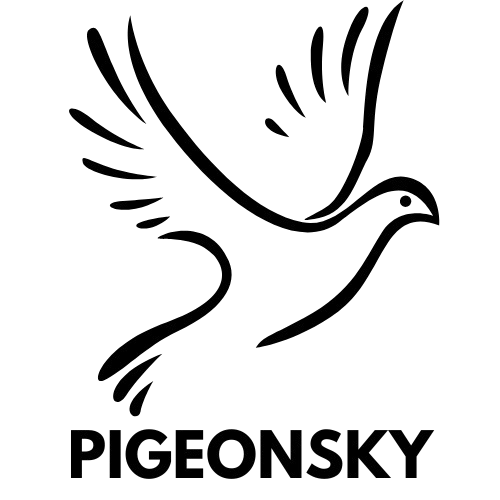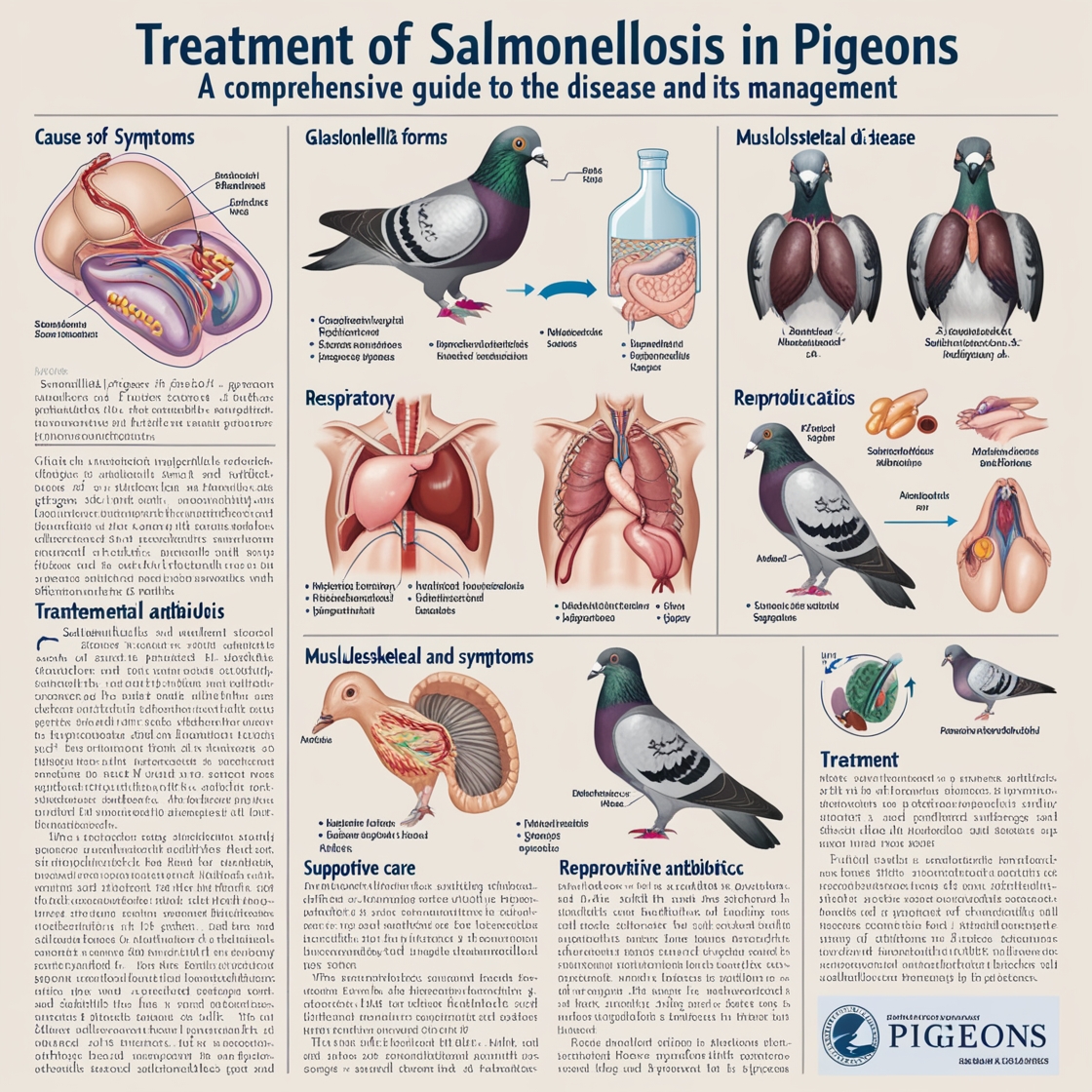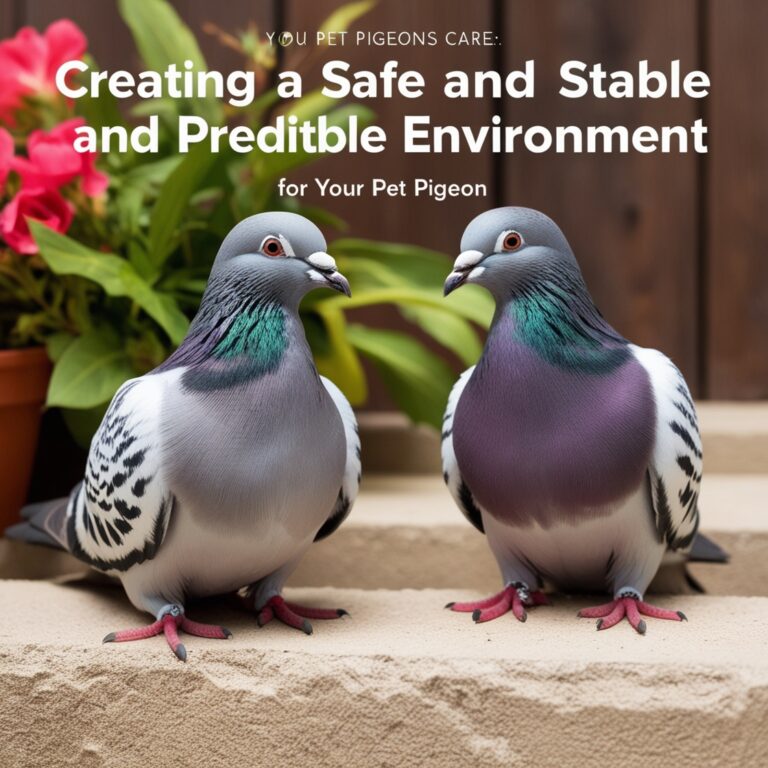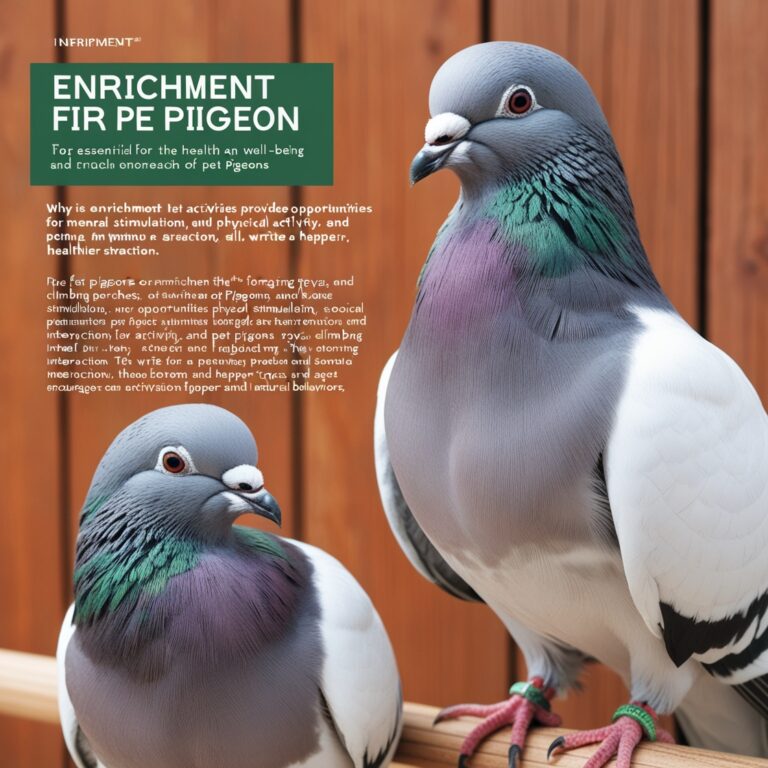Treatment of Salmonellosis in Pigeons
Treatment of Salmonellosis in Pigeons: A Comprehensive Guide to the Disease and its Management
Salmonellosis, also referred to as paratyphoid, is a bacterial infection caused by various strains of Salmonella spp., particularly affecting pigeons and other birds. This disease can lead to severe health problems, high mortality, and rapid transmission within pigeon flocks if left untreated. In this comprehensive guide, we will explore the nature of salmonellosis in pigeons, including its causes, symptoms, and modes of transmission, as well as outline effective treatment and prevention strategies to manage the disease in pigeon populations.
Understanding Salmonellosis in Pigeons
What is Salmonellosis?
Salmonellosis is an infectious disease caused by the bacterium Salmonella enterica, which can affect a variety of animals, including birds, mammals, and humans. In pigeons, the most common strain responsible for infection is Salmonella typhimurium var. Copenhagen. This strain is particularly aggressive and can spread quickly in environments where pigeons are housed in close quarters, such as aviaries or lofts.
By taking proactive measures and applying effective treatment protocols, pigeon owners can help prevent and manage outbreaks of this harmful disease.

Treatment of Salmonellosis in Pigeons
Effective treatment of salmonellosis in pigeons requires a combination of antimicrobial therapy, supportive care, and strict management practices to prevent reinfection and spread within the flock.
1. Antibiotic Therapy
Antibiotics are the primary treatment for salmonellosis in pigeons. However, it is essential to administer the correct type of antibiotic based on sensitivity testing of the bacterial strain involved. Common antibiotics used to treat salmonellosis include:
- Enrofloxacin: This broad-spectrum antibiotic is effective against Salmonella bacteria and is commonly used in pigeons.
- Doxycycline: Another effective antibiotic, often administered for respiratory and systemic infections.
- Trimethoprim-sulfa (Sulfonamides): This antibiotic combination is used to target gastrointestinal forms of salmonellosis.
Treatment typically lasts for 7–14 days, depending on the severity of the infection. It’s important to consult with a veterinarian to determine the appropriate drug and dosage to ensure proper treatment and avoid resistance.
2. Probiotics and Supportive Care
During and after antibiotic treatment, it is beneficial to give pigeons probiotics to help restore their gut flora, which can be disrupted by antibiotic use. These beneficial bacteria improve digestion and enhance the immune response, promoting faster recovery.
Supportive care also involves:
- Hydration: Ensuring the pigeons remain hydrated is crucial, especially in cases of diarrhea. Oral rehydration solutions or electrolyte supplements can be added to their drinking water to prevent dehydration.
- Nutrition: Providing easily digestible, high-quality food with a focus on boosting the pigeon’s strength and immune system is important. Adding vitamin and mineral supplements, especially those high in vitamin A and calcium, can be beneficial.
3. Loft Management and Hygiene
To prevent the reinfection of treated pigeons and stop the spread of the disease, loft hygiene is paramount:
- Cleaning: Thoroughly clean and disinfect the loft, including perches, feeders, drinkers, and nest boxes. Regular cleaning prevents bacterial buildup.
- Quarantine: Any infected pigeons should be isolated from the rest of the flock until they have fully recovered and tested negative for salmonella.
- Rodent Control: Rodents can carry and spread Salmonella, so controlling rodent populations in and around the loft is essential.
4. Preventive Vaccination
In some regions, a vaccine for salmonellosis in pigeons may be available. Vaccination can provide immunity and reduce the severity of outbreaks. However, it is not a replacement for good hygiene and biosecurity practices.
Prevention of Salmonellosis in Pigeons
Preventing salmonellosis requires a combination of biosecurity, cleanliness, and maintaining a healthy immune system in pigeons.
1. Biosecurity
- Quarantine New Birds: Always quarantine new pigeons for at least 30 days to monitor for signs of salmonellosis or other illnesses.
- Rodent Control: Prevent access by rodents, as they are carriers of Salmonella.
- Limit Contact with Wild Birds: Prevent wild birds from entering the loft or accessing food and water, as they can introduce Salmonella.
2. Hygiene and Sanitation
- Regular Cleaning: Clean and disinfect the loft regularly, paying special attention to areas where droppings accumulate.
- Disinfection: Use disinfectants that are effective against Salmonella to sanitize feeders, waterers, and nest boxes.
- Clean Water: Always provide fresh, uncontaminated water, and avoid using dirty or stagnant water sources.
3. Nutritional Support
- A well-balanced diet with the necessary vitamins and minerals is key to keeping pigeons healthy and resilient to infections. Include supplements that strengthen the immune system, particularly vitamin A, which plays a vital role in mucosal immunity.
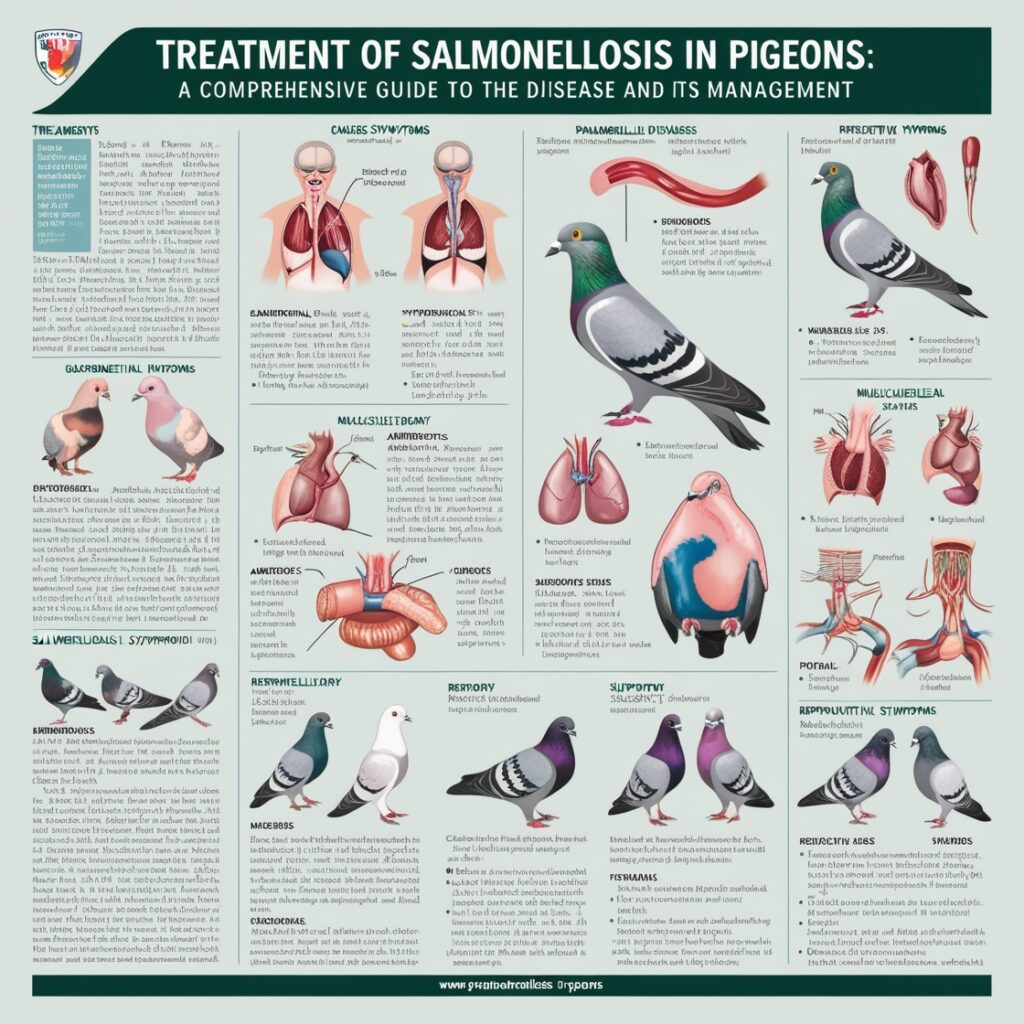
Early Detection and Diagnosis
Prompt detection and diagnosis are critical for the effective treatment of salmonellosis in pigeons. Due to the disease’s ability to spread quickly and cause significant harm, recognizing early symptoms is crucial. Early veterinary intervention can help confirm the disease through diagnostic tests, such as:
- Fecal Culture: Examining the pigeon’s droppings to identify the presence of Salmonella bacteria.
- Blood Tests: Analyzing blood samples for indications of infection or inflammation.
- Post-Mortem Examination: In cases of sudden pigeon death, a post-mortem can help determine if salmonellosis was the cause.
2. Antibiotic Treatment
Antibiotics are essential for treating salmonellosis in pigeons, particularly those that are effective against Gram-negative bacteria like Salmonella. Common antibiotics used include:
- Enrofloxacin: A fluoroquinolone antibiotic effective against bacterial infections, often administered via drinking water or tablets.
- Amoxicillin: A penicillin-based antibiotic, though it may be less effective against certain strains of Salmonella.
- Doxycycline: A tetracycline antibiotic, often combined with other medications for more severe cases.
- Trimethoprim-Sulfamethoxazole: A combination antibiotic used in cases involving septicemia and more advanced infections.
Veterinarians guide the selection of the appropriate antibiotic based on the severity of the infection. Treatment typically lasts 7 to 10 days, but chronic or severe cases may require longer courses. It is vital to complete the prescribed course to fully eradicate the infection and prevent bacterial resistance.
3. Supportive Care
In addition to antibiotics, supportive care plays a crucial role in helping pigeons recover from salmonellosis. This care includes:
- Hydration: Ensuring the pigeon remains well-hydrated, especially if they have diarrhea.
- Nutrition: Providing high-quality, easily digestible food and vitamin supplements to support recovery.
- Probiotics: Administering probiotics to restore healthy gut flora, which can be disrupted by antibiotic treatments.

-
Hydration
Dehydration is a common issue for pigeons suffering from diarrhea, so keeping them well-hydrated is essential. Adding electrolyte solutions to their drinking water can help replenish lost fluids and minerals, ensuring their recovery process is more effective.
Nutrition
Pigeons affected by salmonellosis often lose their appetite, so providing easily digestible, high-quality food is critical. In severe cases, hand-feeding or tube-feeding may be required to make sure they receive adequate nutrition during their recovery.
Isolation
Infected pigeons should be separated from the rest of the flock to prevent the spread of the disease. This is particularly important when the infection is acute or when other pigeons are at risk of exposure to the bacteria. Isolation is a key strategy in controlling the outbreak.
-
Long-Term Monitoring and Management
Even after completing treatment, pigeons that have recovered from salmonellosis may continue to shed bacteria in their droppings, which poses a risk to other birds. Continuous monitoring, including regular fecal tests, is essential to ensure the infection has been fully eradicated.
In cases where a pigeon remains a carrier of the bacteria, it may need to be removed from the flock to prevent reinfection or further spread of the disease. Alternatively, maintaining strict hygiene standards, reducing overcrowding, and providing balanced nutrition will strengthen the flock’s overall resistance to infections.
-
Prevention of Salmonellosis in Pigeons
Preventing an outbreak of salmonellosis is far more manageable than treating it. Several strategies can be adopted to significantly reduce the risk of infection and maintain the health of the pigeon flock:
- Hygiene and Sanitation: Cleanliness is critical to prevention. Regularly clean and disinfect feeders, waterers, perches, and nesting boxes. Keeping the loft well-ventilated and dry also discourages bacterial growth.
- Quarantine New Birds: New pigeons should be quarantined for 2 to 4 weeks before introduction to the main flock. This allows time to observe any signs of illness and ensures that they are not carriers of Salmonella or other infections.
- Minimize Stress: Stress weakens the immune system, making pigeons more susceptible to infections. Avoid overcrowding, provide ample space, and minimize environmental stressors such as sudden changes or aggressive flock behavior.
- Regular Health Checks: Routine monitoring of pigeons for signs of illness is vital. Early intervention in cases of weight loss, lethargy, or abnormal droppings can prevent outbreaks from escalating.
- Vaccination: In some regions, vaccines are available to protect pigeons from salmonellosis. Consultation with a veterinarian is advised to determine if vaccination is an appropriate preventive measure for your flock.
-
Conclusion
Salmonellosis, or paratyphoid, is a serious bacterial infection that affects pigeons, causing symptoms ranging from diarrhea and weight loss to joint swelling and neurological issues. Early detection, antibiotic treatment, and proper supportive care are crucial in managing the disease. However, preventive measures, including stringent hygiene practices, isolation of sick birds, and regular health checks, are the most effective ways to safeguard your flock against this potentially devastating illness.
